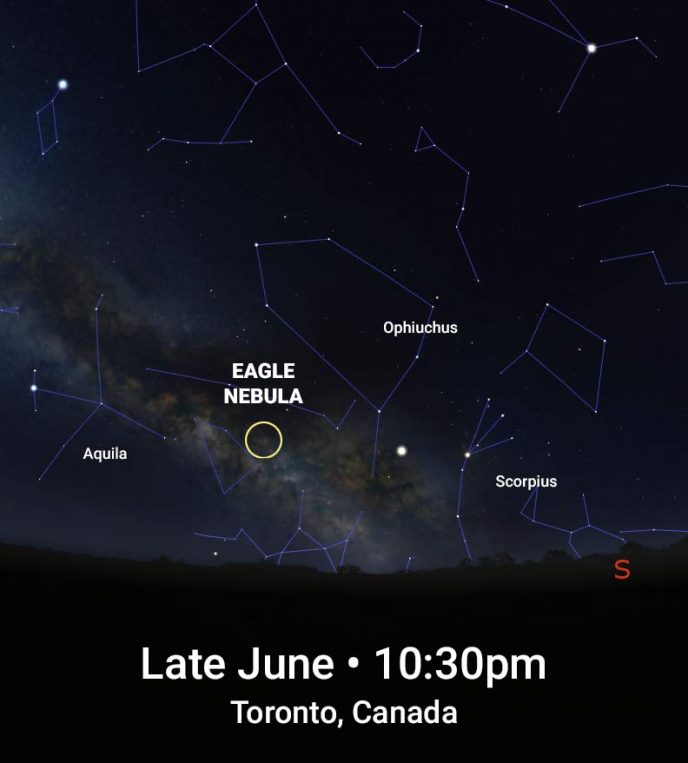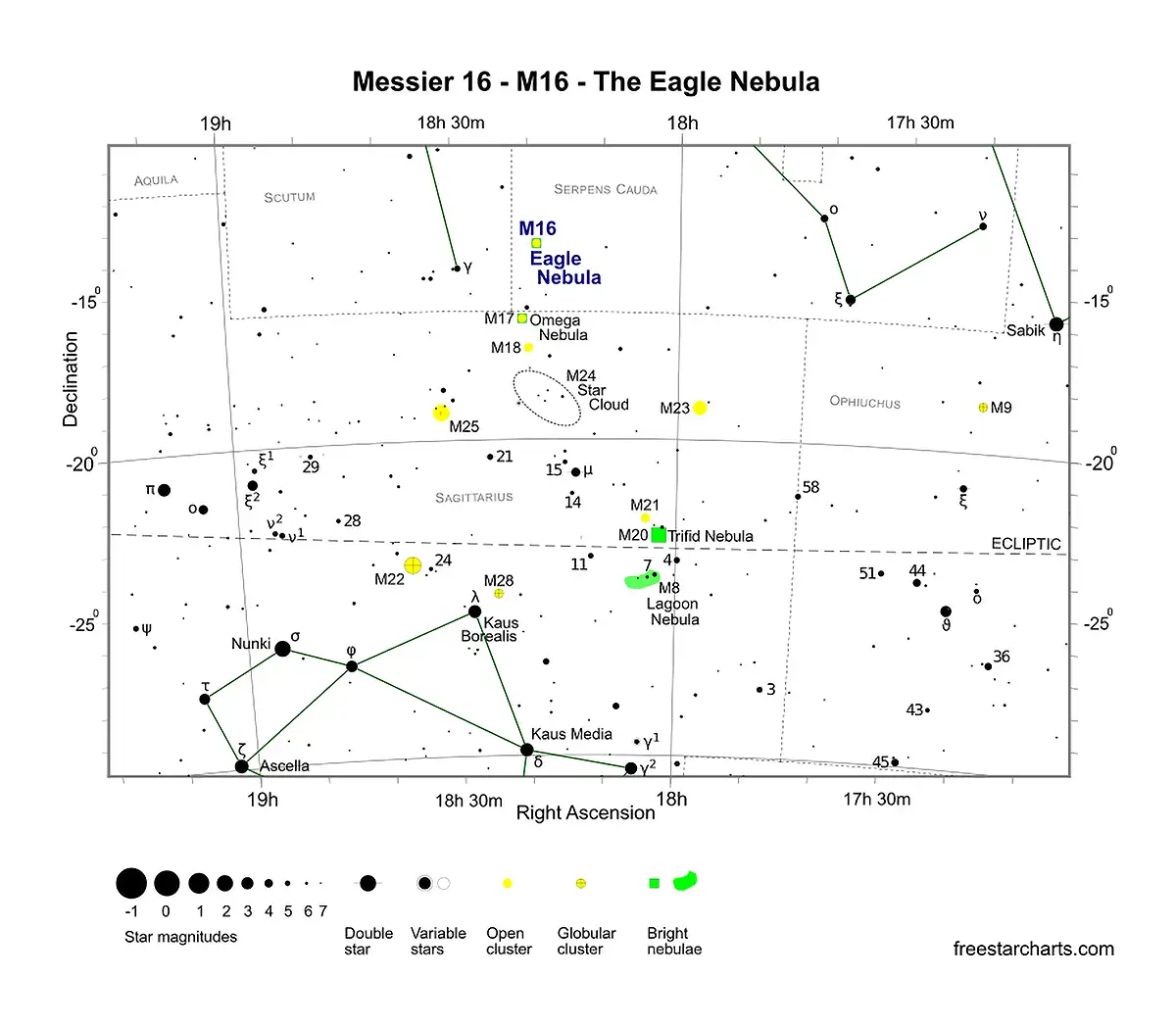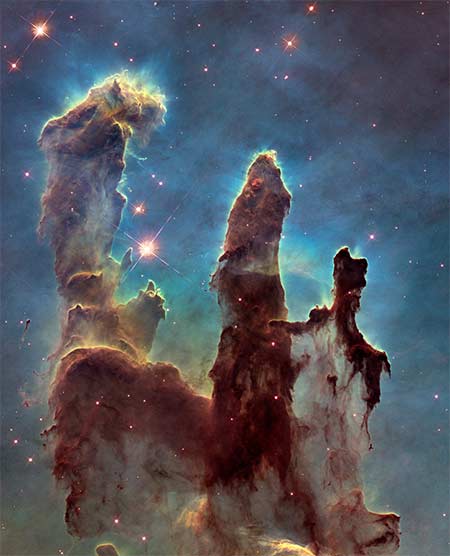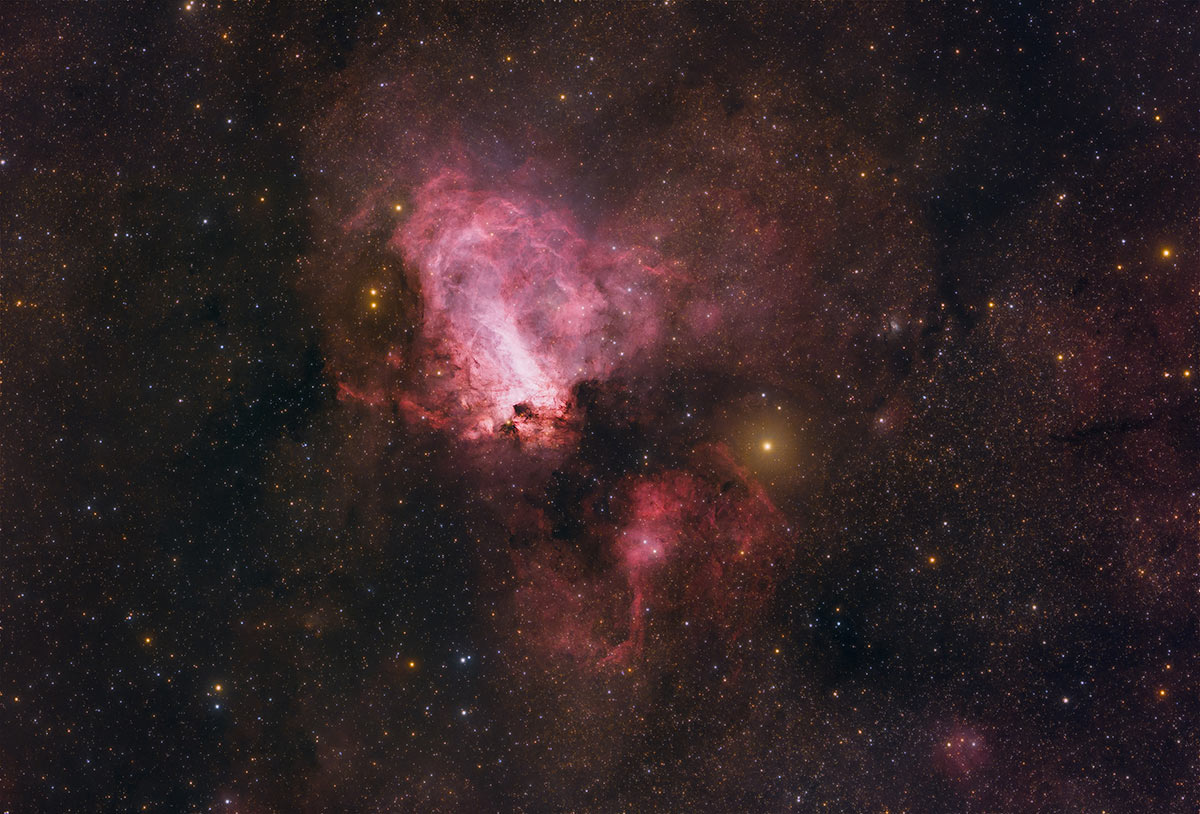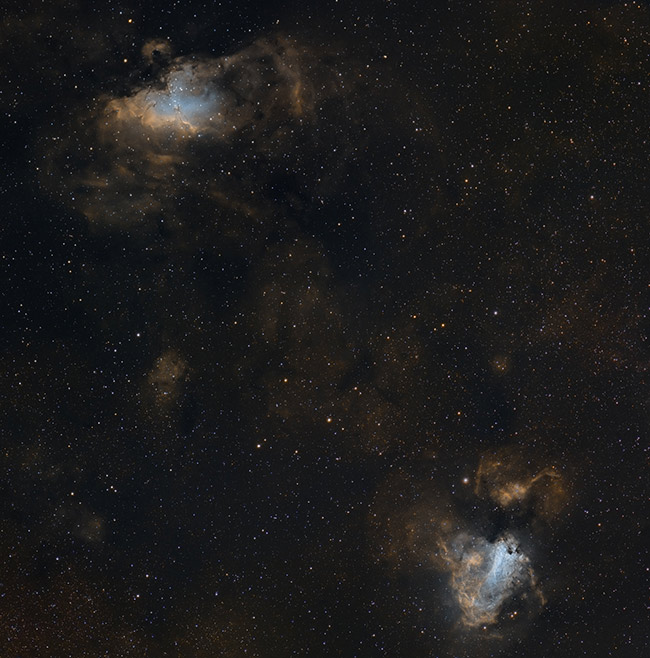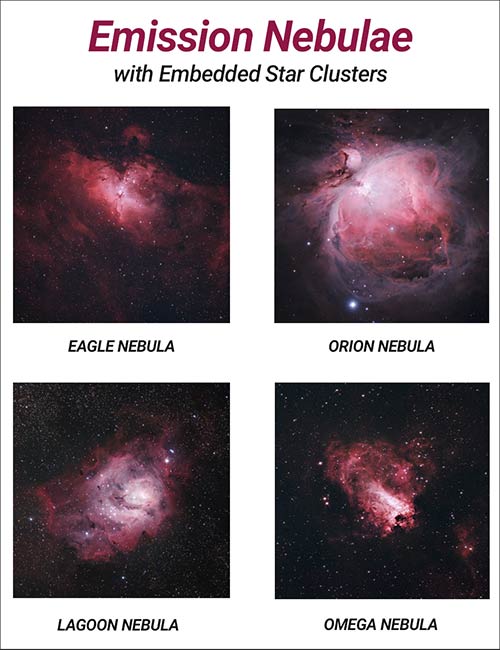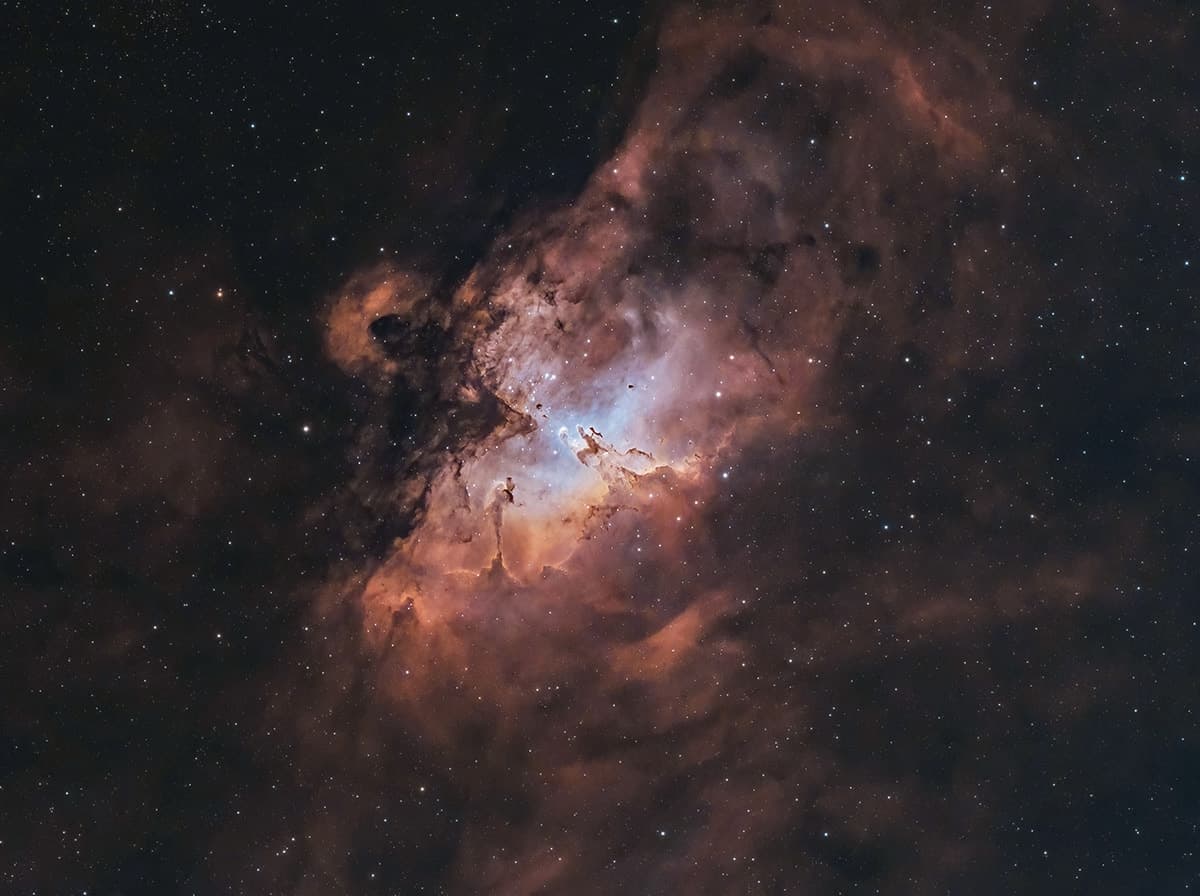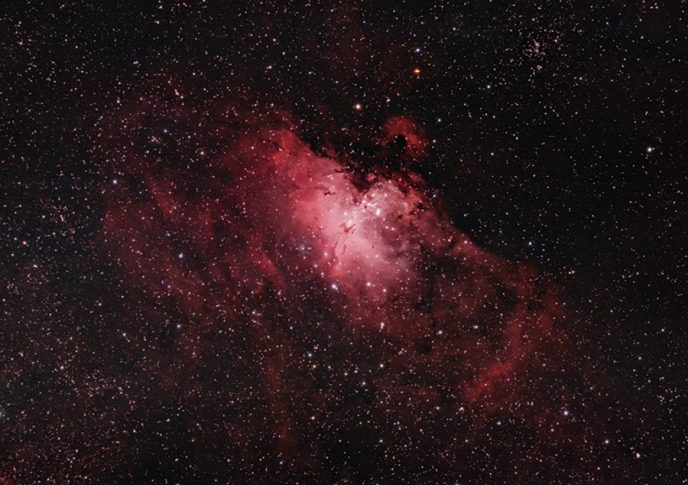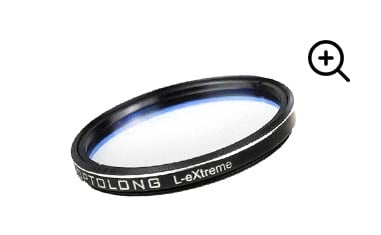M16 – The Eagle Nebula
M16 (Messier 16) is known by amateur astronomers and astrophotographers as the Eagle Nebula. It is one of the brightest nebulae in the night sky, and is visible in both the northern and southern hemispheres.
The Eagle Nebula is a large cloud of gas and dust where new stars are born. When you take a look at the wispy glow of this nebula through an astronomical telescope or binoculars, you are witnessing a stellar object that is approximately 7000 light-years away.
The Eagle Nebula captured using my camera and telescope in the backyard.
The newborn stars in the Eagle Nebula are very hot, which illuminates M16’s hydrogen gas as seen in the Pillars of Creation, made famous by the Hubble Space Telescope.
These intense pillars are slowly evaporating under the intense glare of the nearby massive, newborn stars. The Pillars of Creation appear relatively small within the nebula itself, but in actuality, they are larger than our entire solar system.
The Eagle Nebula
The Eagle Nebula is a bright (magnitude 6.2) emission nebula in the constellation Serpens. From mid-northern latitudes, it reaches an apparent altitude high enough in the southern sky for visual observation or photography.
It contains several active star-forming regions of gas and dust and is one of the brightest nebulae in our night sky. “The Eagle” can easily be identified in long-exposure images of the Milky Way like the one shown below.
The location of the Eagle Nebula in our night sky. (DSLR camera and lens on a star tracker).
As is the case with all deep-sky astrophotography targets, the key to a successful image of the Eagle Nebula is an adequate amount of integration time for a healthy signal-to-noise ratio.
For those using a GoTo equatorial telescope mount, you’ll land on the Eagle Nebula by punching in M16, or NGC 6611, into the keypad of the hand controller. NGC 6611 designates the embedded star cluster associated with this nebula, containing many hot, blue stars.
Eagle Nebula Details
The Eagle Nebula is impressive to view through the eyepiece of a Dobsonian telescope and looks even better through astrophotography. Because of it’s size and brightness, M16 is a great target to try with your smart telescope.
It’s one of the most awe-inspiring deep-sky objects I’ve ever photographed using a camera and telescope. Whether it’s a stock DSLR camera or a dedicated astronomy camera and filters, M16 always delivers.
It’s pretty surreal when you realize that you can capture the iconic Pillars of Creation with a small refractor telescope and a color camera. Here are some fast facts about the Eagle Nebula:
- Messier: 16
- NGC: 6611 (embedded star cluster)
- IC: 4073
- Object Type: Emission Nebula with Open Cluster
- Constellation: Serpens
- Distance: 7000 light-years
- Apparent Magnitude: +6.2
- Apparent Size: 65 x 50 Arc Minutes
Location & Best Time to See it
The best time to look for the Eagle Nebula from mid-northern latitudes is from June to September. A mobile stargazing app like Stellarium will help you find the Eagle Nebula in the night sky from your location.
Below, you will see an image showing the Eagle Nebula’s location at nightfall in June. By September/October (from this latitude), this nebula sits high into the southwest at nightfall and quickly fades into the horizon as the night progresses.
The location of the Eagle Nebula from mid-northern latitudes. (Image created using Stellarium)
Unlike the northern constellations that are visible at all times of the year, Serpens and the Eagle Nebula offer a relatively short window of opportunity for viewing.
If you have obstructions in your yard, such as trees and neighboring houses, it may be hard to spot the Eagle Nebula. This becomes more of an issue the higher the latitude you are at (I am at 43 degrees north, for reference).
M16 Star Chart. (freestarcharts.com)
The Serpens Constellation
The Eagle Nebula resides in the constellation Serpens, which translates to “the serpent” in Latin.
Serpens is a unique constellation because it is the only one that splits into two parts. Serpens Cauda (tail), and Serpens Caput (head).
It stretches all the way around Ophiuchus and is best visualized on a star map with constellation art.
An illustration from 1825 depicting Serpens and Ophiuchus.
The Eagle Nebula sits in Serpens Cauda, the snake’s tail. This constellation is also home to Messier 5 (NGC 5904), a bright globular cluster lying approximately 24,500 light-years from Earth.
Not too far below, you’ll find the Omega Nebula, in an entirely new constellation, Sagittarius.
The Pillars of Creation
In 1995, the Hubble Space Telescope captured one of the most iconic images of all time, the “Pillars of Creation”. I remember seeing this image as a child, and it captivated my imagination. I never thought that I would one day photograph this region of space myself.
This is one of the most productive regions of active star formation in the night sky. Stars are forming inside the massive pillars of gas and dust, and are being sculpted by the powerful winds of the young, energetic stars within M16’s cluster.
The “Pillars of Creation” – NASA, ESA, and The Hubble Heritage Team (STScI / AURA).
“Stars are forming deep inside the towering structures. The light-years long columns of cold gas and dust are some 6,500 light-years distant in M16, the Eagle Nebula, toward the constellation Serpens. Sculpted and eroded by the energetic ultraviolet light and powerful winds from M16’s cluster of young, massive stars, the cosmic pillars themselves are destined for destruction.”
NASA APOD – Januray 7, 2015
In 2021, I took a picture of the Pillars of Creation myself using my backyard telescope and compared it to Hubble’s version.
The Nearby Omega Nebula (Swan Nebula)
The Omega Nebula (M17) is located just below the Eagle Nebula in a separate constellation, Sagittarius.
M17 (also known as the “Swan Nebula”) is another H II region of the night sky and is equally stunning as M16.
As you can imagine, this is a dense and populated area of the night sky and one that amateur astrophotographers spend a lot of time photographing.
The Swan/Omega Nebula in Sagittarius lies very close to the Eagle Nebula in Serpens.
In a wide-field photo of the area, the proximity of the Eagle to the Swan Nebula becomes very apparent. The picture below was taken using a focal length of 250mm (William Optics RedCat 51).
The Eagle Nebula and Omega Nebula lie very close to each other from our perspective on Earth. (Greg Turgeon)
Both the Eagle and the Swan lie along the Sagittarius spiral arm near the center of our Milky Way galaxy.
For a better idea of the scale of these objects, the extended wings of M16 spread nearly 120 light-years wide, while the Omega Nebula (or Swan Nebula) spans 30 light-years across.
Other Emission Nebula with Embedded Star Clusters
Emission nebulae with embedded star clusters are actually pretty common throughout our galaxy, and they make for some of the most photogenic targets we can shoot from the backyard.
These glowing clouds of ionized gas are lit up by young, hot stars forming right inside them. Targets like the Eagle Nebula, the Rosette, or NGC 2264 are perfect examples, and they’re surprisingly accessible with modest gear.
Some other famous H II regions include the Orion Nebula, the Lagoon Nebula, and the Omega Nebula.
Other famous emission nebulae with embedded star clusters:
These types of targets are surprisingly accessible with modest astrophotography equipment. I’ve found that dual-narrowband filters really help bring out the emission detail while keeping those embedded stars crisp and well-defined, even under heavy light pollution.
Astrophotography
As far as deep-sky astrophotography targets go, the Eagle Nebula is quite big and bright. With an apparent magnitude of +6.2, even a short 30-second exposure is enough to start recording the intense glow of the core.
From the city, you can expect to capture about 1-2 hours’ worth of integrated exposure time before revealing the faint details of the outer nebula regions. This target tends to “grow” as you add more and more exposure time.
A dual-narrowband filter will help tremendously when capturing the Eagle Nebula from light-polluted skies. The only downside of this method is that you will lose the natural star colors in the image.
The following image was captured using a 6-inch apochromatic refractor telescope with a dedicated astronomy camera attached. The final image includes about 5 hours of total exposure time using a light pollution filter.
The Eagle Nebula by Trevor Jones.
You can also use a DSLR camera to photograph M16. The following image was captured using a Canon EOS Rebel XSi modified for astrophotography by removing the stock internal IR cut filter.
Photo of the Eagle Nebula using a DSLR Camera and Refractor Telescope.
Recommend Astrophotography Gear
If you are looking to photograph the Eagle Nebula yourself, I have some recommendations for you regarding astrophotography equipment.
The great news is, you can take an incredible photo of the M16 using modest, entry-level gear. This includes a simple DSLR camera and lens on a tripod.
To compensate for the rotation of the Earth, it is wise to use a star tracker (or tracking telescope mount). This will allow you to take longer exposures of the Eagle Nebula and reveal more data.
Here is an example of a very capable deep-sky imaging system you can use to photograph M16 in detail. The telescope shoots at a focal length of 250mm (Askar SQA55).
Askar SQA55 telescope, ZWO ASI2600MC Air, and a Sky-Watcher Star Adventurer GTi.
A dual-narrowband filter like the Optolong L-eXtreme is handy when photographing emission nebulae from the city.
This will ignore most of the city light pollution, but allow the critical wavelengths of gas from the nebulae to pass through to the image sensor.
For more astrophotography images, please visit the photo gallery. Please follow the AstroBackyard YouTube Channel for the most up-to-date information.
For a detailed walkthrough of the image processing techniques used in the images above, please visit the astrophotography tutorials section of this website.


